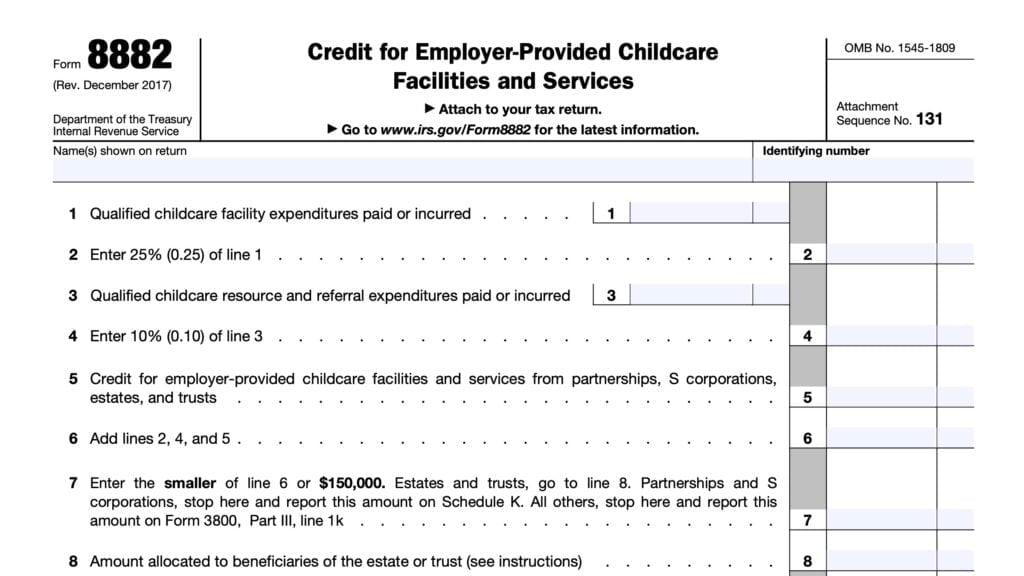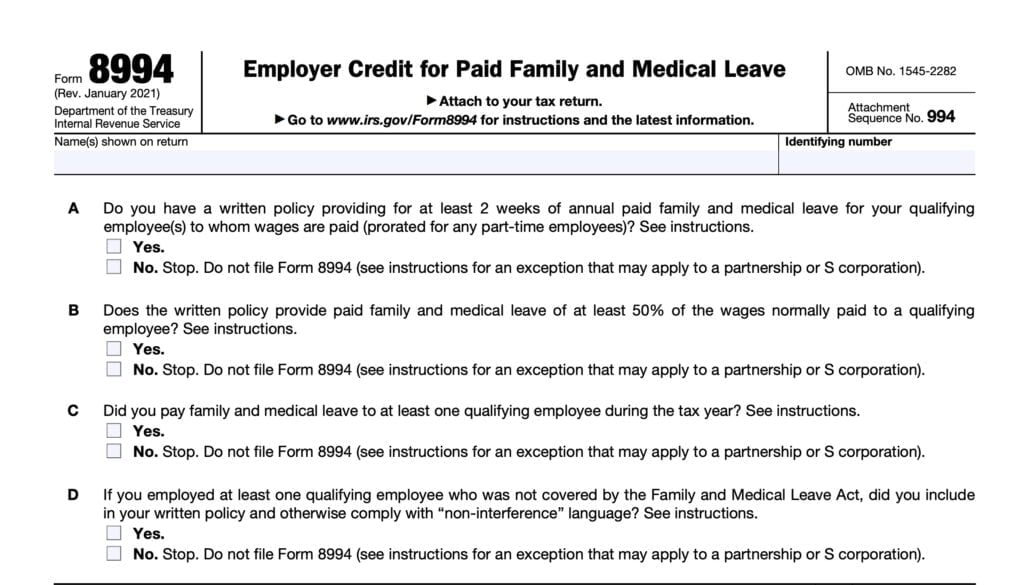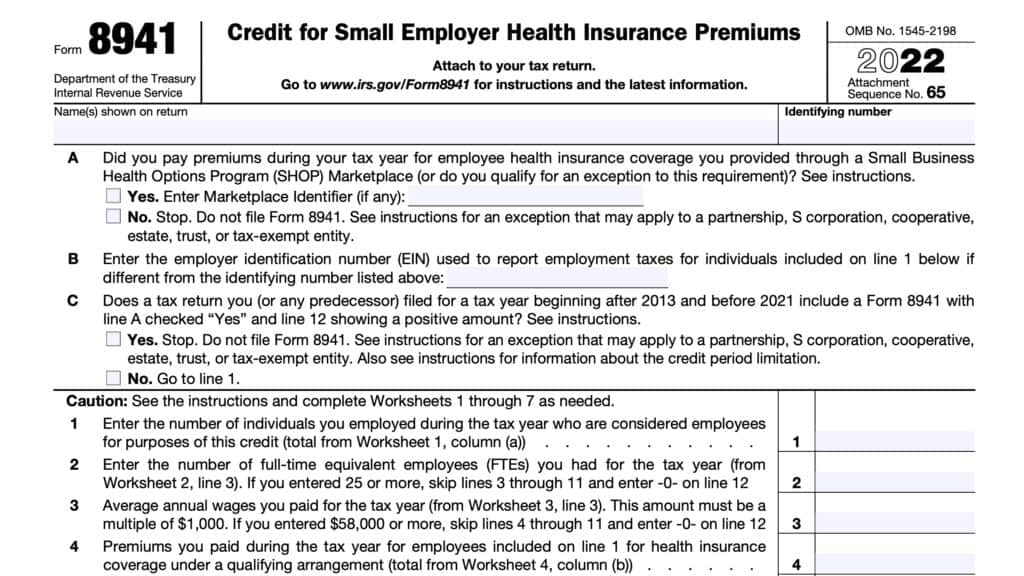IRS Form 941 Instructions
If you’re an employer who pays wages and compensation that are subject to federal tax withholding or payroll taxes, then you may need to report wages and withheld taxes on IRS Form 941, Employer’s QUARTERLY Federal Tax Return.
In this article, we’ll help you better understand everything you need to know about this tax form, including:
- How to complete IRS Form 941
- Filing considerations
- Frequently asked questions
Let’s begin with step by step guidance on completing IRS Form 941.
Table of contents
How do I complete IRS Form 941?
There are 5 parts to this two-page IRS tax form:
- Part 1: Answer these questions for this quarter
- Part 2: Tell us about your deposit schedule and tax liability for this quarter
- Part 3: Tell us about your business
- Part 4: May we speak with your third-party designee?
- Part 5: Sign here
Before we start with Part 1, let’s take a look at the taxpayer information at the very top of IRS Form 941.
Top of form
At the very top, you’ll include information about the employer, as the quarter for which you are reporting.
Employer identification number
In this field, enter the 9-digit employer ID number, or EIN, for the business. If you do not already have an EIN, you may apply for one online through the IRS website or by filing Form SS-4, Application for Employer Identification Number.
Do not enter your Social Security number (SSN) or individual taxpayer identification number (ITIN) in this field.
Name
Enter the name that you used when applying for your EIN. If you are a sole proprietor, you may enter your personal name here, then enter the name of your business under Trade Name, below.
Trade Name
If applicable, enter your trade name here. If your trade name and the name you used to apply for your EIN are the same, then leave this field blank.
For example, Haleigh Smith is a sole proprietor who operates a business called Haleigh’s Bicycles. Haleigh would enter her information as follows:
- Name: Haleigh Smith
- Trade name: Haleigh’s Bicycles
Address
Enter your business address here. Include the following information:
- Street name and number
- Suite or room number, if applicable
- City, state, and ZIP code
If your business is located in a foreign country, then enter the foreign country’s name, province or county, and postal code in the space provided.
Change of business name, address, or responsible party
Immediately notify the IRS if you change your business name, business address, or responsible party. You can do this in one of two ways:
- Write to the IRS office where you file your returns to notify the IRS of any business name change.
- Complete and mail IRS Form 8822-B, Change of Address or Responsible Party – Business, to notify the IRS of a business address or responsible party change.
- Don’t mail your completed Form 8822-B with your Form 941.
Report for this quarter
On the right-hand side of the form, check the appropriate box, based on the month and quarter that you’re filing for:
- Quarter 1: January, February, or March
- Quarter 2: April, May, or June
- Quarter 3: July, August, or September
- Quarter 4: October, November, or December
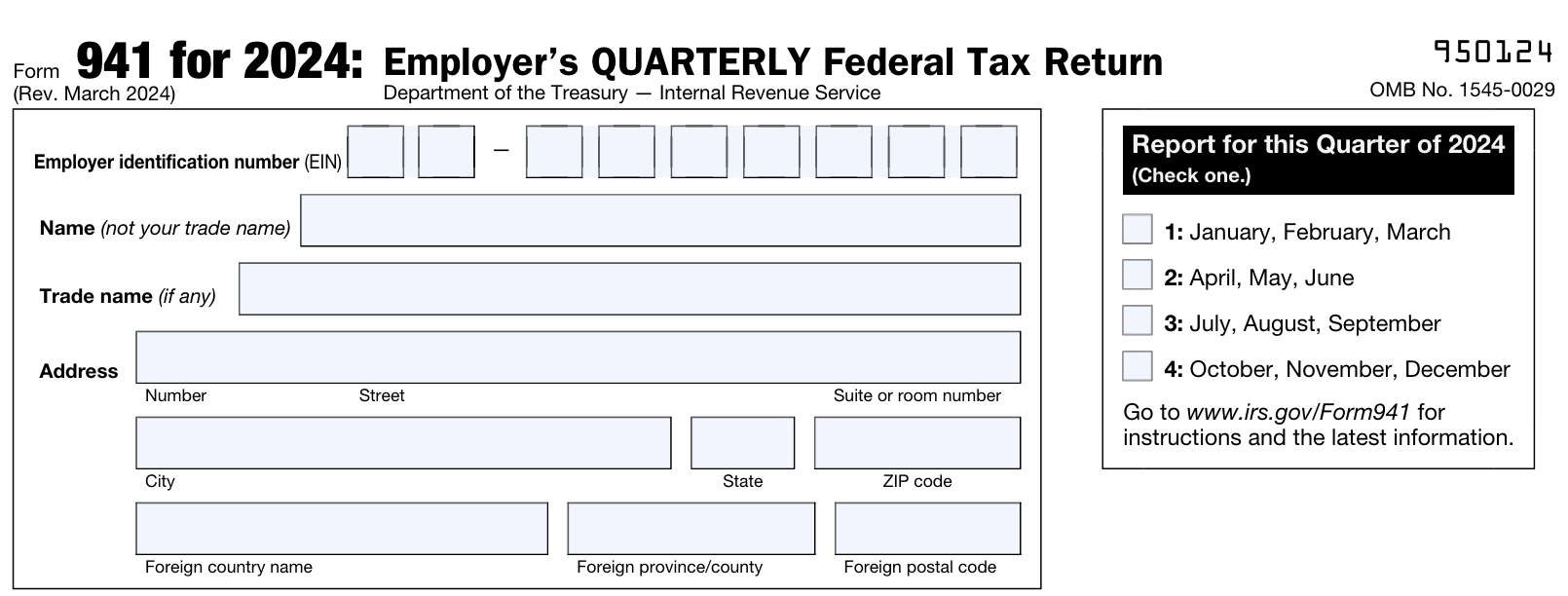
Once we’ve completed the taxpayer information fields, we can proceed to Part 1.
Part 1: Answer these questions for this quarter
In Part 1, we’ll answer specific questions about employee compensation, taxes, and credits for the reporting quarter.
Line 1: Number of employees who received wages, tips, or other compensation
In Line 1, enter the number of employees on your payroll for the pay period that includes one of the following dates for the quarter that you indicated at the top of the form:
- March 12
- June 12
- September 12
- December 12
When listing the number of employees, do not include any of the following individuals:
- Household employees
- Employees in nonpay status for the pay period
- Farm employees
- Pensioners
- Active members of the U.S. Armed Forces
Line 2: Wages, tips, and other compensation
Enter the total amount of wages paid in the quarter that you would have also included in Box 1 for each employee’s IRS Form W-2, Wage and Tax Statement.
Sick pay
Include sick pay paid by your agent. Also include sick pay paid by a third party that isn’t your agent (for example, an insurance company) if:
- You were given timely notice of the payments, and
- The third party transferred liability for the employer’s taxes to you
If you’re a third-party payer of sick pay and not an agent of the employer, don’t include sick pay that you paid to policyholders’ employees here if you gave the policyholders timely notice of the payments.
Section 6 of IRS Publication 15-A, Employer’s Supplemental Tax Guide, contains more information about sick pay reporting and the procedures for transferring the liability to the employer.
Line 3: Federal income tax withheld from wages, tips, and other compensation
Enter the federal income taxes that you withheld, or that the IRS required you to withhold, from your employees on all of the following from this quarter:
- Wages
- Tips
- Taxable fringe benefits
- Supplemental unemployment compensation benefits
Do not include income tax that a third-party payer of sick pay withheld, even if you reported it on Form W-2. You will reconcile this difference on IRS Form W-3, Transmittal of Wage and Tax Statements.
Also include any excise taxes that you were required to withhold on golden parachute payments, in accordance with Internal Revenue Code Section 4999.
If you’re a third-party payer of sick pay, enter the federal income tax you withheld (or were required to withhold) on third-party sick pay here.
Additional information
IRS Publication 15-B, Employer’s Tax Guide to Fringe Benefits, contains additional information on the employment tax treatment of fringe benefits
For information about supplemental unemployment compensation benefits and golden parachute payments, see Section 5 of Pub. 15-A.
Line 4
If no wages, tips, and other compensation listed on Line 2 are subject to Social Security or Medicare tax, check this box and go to Line 6, below.
If this question doesn’t apply to you, leave the box blank.
For more information about exempt wages, see Section 15 of IRS Publication 15, Employer’s Tax Guide. For religious exemptions, refer to Section 4 of Publication 15-A.
Line 5a: Taxable Social Security wages
In Column 1, enter the total wages, sick pay, and taxable fringe benefits subject to Social Security taxes that you paid to your employees during the quarter. Include the amount before payroll deductions. However, do not include tips here (see Line 5b, below).
For this purpose, sick pay includes payments made by an insurance company to your employees for which you received timely notice from the insurance company.
For additional information on types of wages subject to Social Security taxes, see Section 5 of Pub. 15.
Social Security tax Calculations
Once you’ve determined the total Social Security wages for Column 1, multiply this amount by the Social Security tax rate. For 2024, this amount is 12.4%.
Enter the result in Column 2.
Social Security Tax Rate
For 2024, the Social Security tax on wages is 6.2% for both the employer and the employee. When you combine both the employer and employee responsibility for Social Security tax, you arrive at the 12.4% used to calculate the total Social Security tax.
Social Security wage base
The tax on Social Security wages are subject to a dollar limit known as the contribution and benefit base, sometimes referred to as the wage base limit. For 2024, the wage base limit is $168,600.
When an employee’s taxable wages and tips (see Line 5b) reach $168,600 for the year, stop withholding Social Security tax or reporting Social Security compensation for that employee.
However, continue to withhold federal income tax and Medicare taxes for the whole year on all wages and tips, even after reaching the Social Security wage base.
Line 5b: Taxable Social Security tips
In Column 1, enter all tips your employees reported to you during the quarter until the total of the tips and taxable wages, including wages reported on Line 5a, for an employee reaches $168,600 for the year.
Include all tips your employee reported to you even if you were unable to withhold the employee tax of 6.2%. You will reduce your total taxes by the amount of any uncollected employee share of social security and Medicare taxes on tips later on Line 9.
Do not include service charges here.
Employee tips
Employees must report tip income to their employer no later than the 10th of the month following the month in which tips were received. Although not required, employees may use the following IRS forms to keep track of and report tip income:
Allocated tips
Don’t include allocated tips on this line. Instead, report them on IRS Form 8027, Employer’s Annual Information Return of Tip Income and Allocated Tips.
Allocated tips aren’t reportable on Form 941 and aren’t subject to withholding of federal income, Social Security, or Medicare tax.
Social Security Tax Calculations on tip income
Calculate the tax on Social Security tips in the same manner as you calculated the tax on Social Security wages in Line 5a, above.
Line 5c: Taxable Medicare wages and tips
In Column 1, enter all wages, tips, sick pay, and taxable fringe benefits that are subject to Medicare tax. Unlike Social Security wages, there is no limit on the amount of wages subject to Medicare tax.
Once you’ve determined the total Medicare wages and tips for Column 1, multiply this amount by the Medicare tax rate. For 2024, this amount is 2.9%.
Enter the result in Column 2.
Medicare Tax Rate
For 2024, the Social Security tax on wages is 1.45% for both the employer and the employee. When you combine both the employer and employee responsibility for Medicare tax, you arrive at the 2.9% used to calculate the total Medicare tax.
Line 5d: Taxable wages and tips subject to Additional Medicare Tax withholding
In Column 1, enter all wages, tips, sick pay, and taxable fringe benefits that are subject to Additional Medicare Tax withholding.
Multiply the Column 1 amount by 0.9% to arrive at the Additional Medicare Tax in Column 2.
Additional Medicare Tax withholding
Employers must begin withholding Additional Medicare Tax in the pay period in which you pay wages in excess of $200,000 to an employee and continue to withhold it each pay period until the end of the calendar year.
Additional Medicare Tax is only imposed on the employee. There is no employer share of Additional Medicare Tax.
All wages that are subject to Medicare tax are subject to Additional Medicare Tax withholding if paid in excess of the $200,000 withholding threshold.
Once wages and tips exceed the $200,000 withholding threshold, include all tips your employees reported during the quarter, even if you were unable to withhold the employee tax of 0.9%.
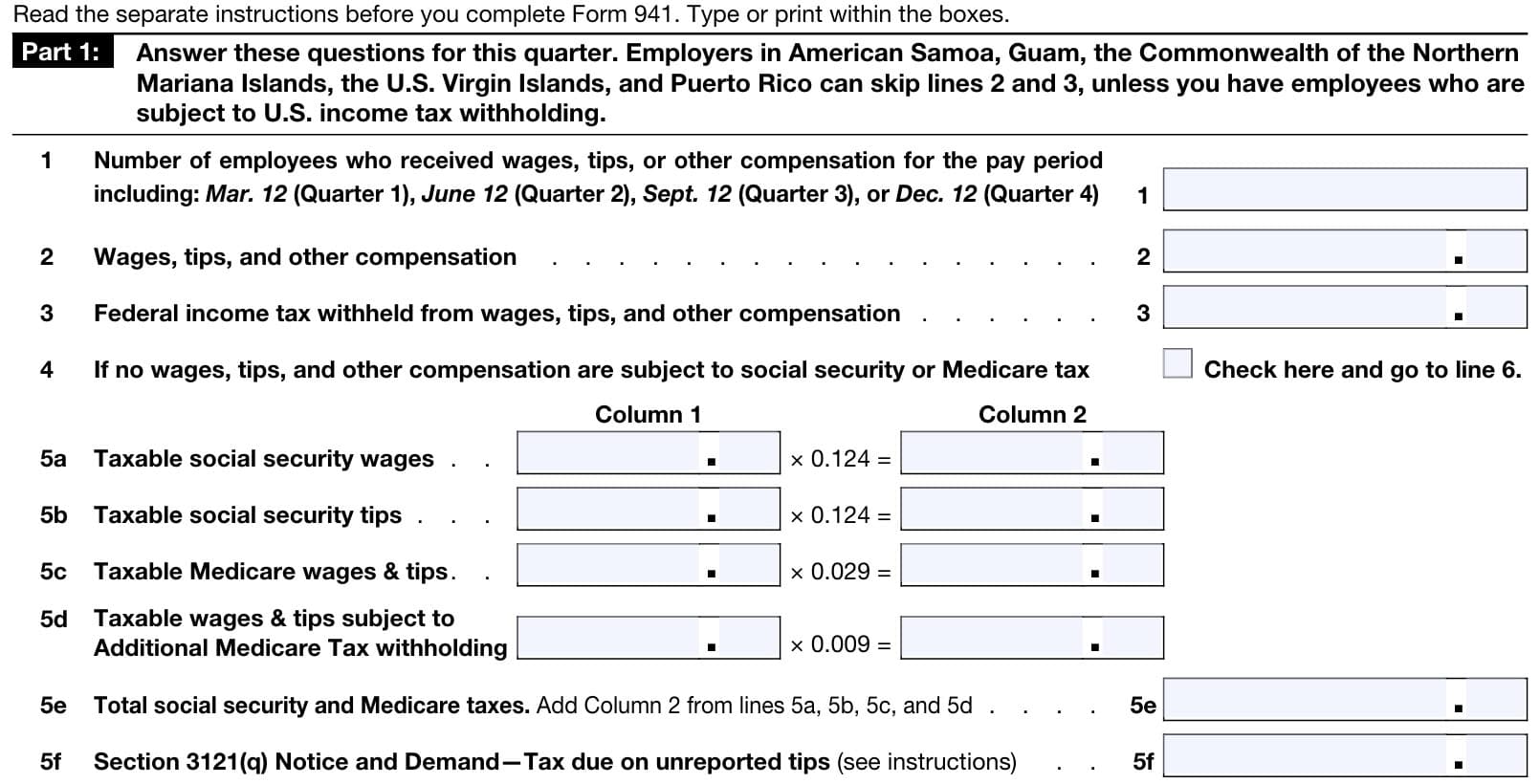
Line 5e: Total Social Security and Medicare taxes
Add the Column 2 amounts on Lines 5a through 5d. Enter the result on Line 5e.
Line 5f: Section 3121(q) Notice and Demand – Tax Due on Unreported Ttips
If you received a Section 3121(q) Notice and Demand, then enter the tax due from your notice on Line 5f.
Section 3121(q) Notice and Demand
The IRS issues a Section 3121(q) Notice and Demand to advise an employer of the amount of tips received by employees who failed to report or underreported tips to the employer.
An employer is not liable for the employer share of the social security and Medicare taxes on unreported tips until the IRS makes a notice and demand to the employer in a Section 3121(q) Notice and Demand.
The tax due may have been determined from tips reported to the IRS on IRS Form 4137, Social Security and Medicare Tax on Unreported Tip Income, or other tips that weren’t reported to their employer as determined by the IRS during an examination.
Line 6: Total taxes before adjustments
Add the following taxes:
- Line 3: Total federal income tax withheld from wages, tips, and other compensation
- Line 5e: Total Social Security and Medicare taxes before adjustments
- Line 5f: Taxes due under a Section 3121(q) Notice and Demand
Enter the total here.
Line 7: Current quarter’s adjustment for fractions of cents
For Lines 7 through 9, enter tax amounts that result from current quarter adjustments. The IRS requests that employers use a minus sign to indicate a negative number, instead of parentheses.
In Line 7, enter adjustments for fractions of cents (due to rounding) corresponding to the employee share of Social Security and Medicare taxes withheld.
The employee share of amounts shown in Column 2 of Lines 5a–5d may differ slightly from amounts actually withheld from employees’ pay due to the rounding of Social Security and Medicare taxes based on statutory rates.
Line 8: Current quarter’s adjustment for sick pay
If your third-party payer of sick pay that isn’t your agent transfers the liability for the employer share of the Social Security and Medicare taxes to you, then enter a negative adjustment here for the employee share of Social Security and Medicare taxes on sick pay that your third-party sick pay payer deposited.
If you’re the third-party sick pay payer and you transferred the liability for the employer share of the Social Security and Medicare taxes to the employer, enter a negative adjustment on Line 8 for any employer share of these taxes that the employer must pay.
Sick pay paid through a third party as an employer’s agent
No adjustment is reported on Line 8 for sick pay that is paid through a third party as an employer’s agent.
An employer’s agent bears no insurance risk and is reimbursed on a cost-plus-fee basis for payment of sick pay and similar amounts. Unless the employer has an agency agreement in place that requires the third-party payer to collect, report, and pay employment taxes on sick pay, if an employer uses an agent to pay sick pay, the employer reports in the following manner:
- Line 5a & Line 5c: Wages
- Line 5d: (if the withholding threshold is met)
Line 9: Current quarter’s adjustments for tips and group-term life insurance
Enter a negative adjustment for either of the following:
- Any uncollected employee share of Social Security and Medicare taxes on tips, and
- The uncollected employee share of Social Security and Medicare taxes on group-term life insurance premiums paid for former employees
Line 10: Total taxes after adjustments
Combine Lines 6 through 9. Enter the result in Line 10.
This is the total amount of taxes after adjustments.
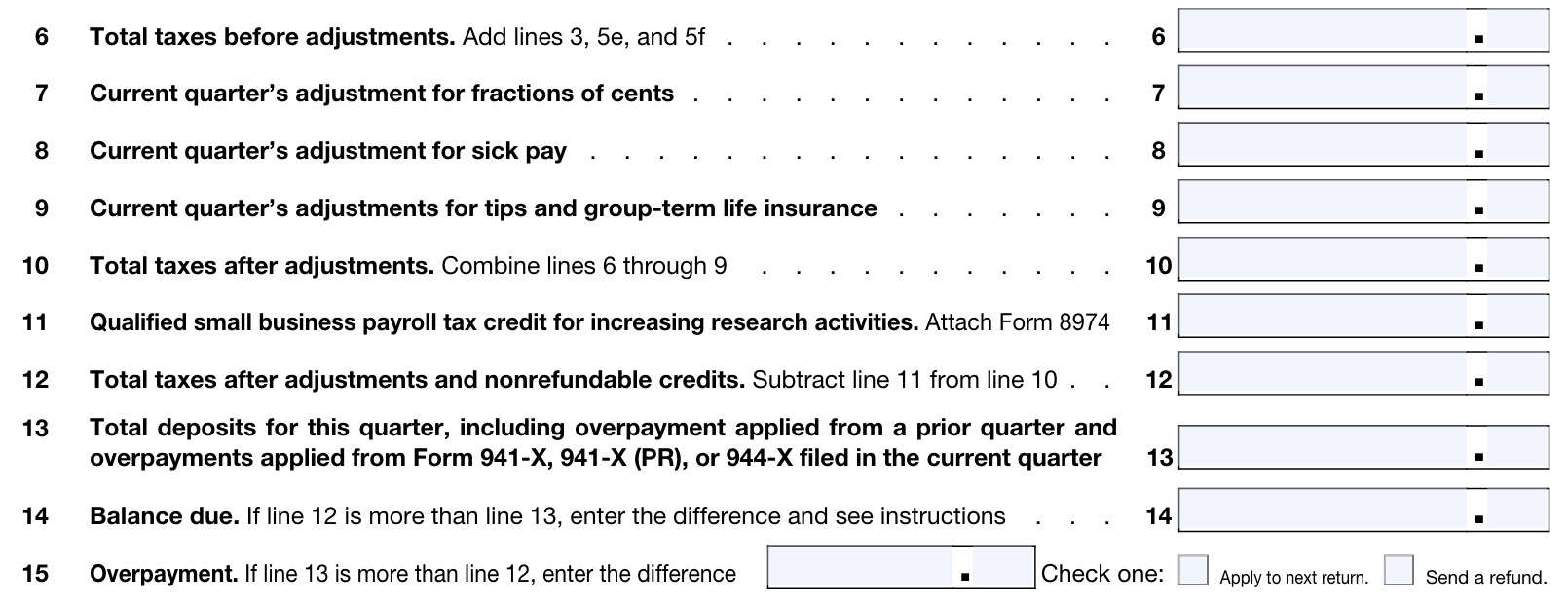
Line 11: Qualified small business payroll tax credit for increasing research activities
In Line 11, enter the amount of the small business payroll tax credit for increasing research activities, as reported on IRS Form 8974. You can find this amount on either:
- Line 12: Credit against the employer share of social security tax
- Line 17: Total credit
If you enter an amount here, you must attach the completed Form 8974.
Line 12: Total taxes after adjustments and nonrefundable credits
Subtract Line 11 from Line 10, then enter the result. However, the amount entered on Line 12 cannot be a negative number.
If Line 12 is less than $2,500 or Line 12 on the prior quarterly return was less than $2,500, and you didn’t incur a $100,000 next-day deposit obligation during the current quarter
You may pay the amount with Form 941 or you may deposit the amount.
To avoid penalties, you must pay any amount you owe in full with a timely filed return or you must deposit any amount you owe before the due date of the return. Line 14 contains additional instructions on paying with a timely filed return.
If Line 12 is $2,500 or more and Line 12 on the prior quarterly return was $2,500 or more, or if you incurred a $100,000 next-day deposit obligation during the current quarter
You must make required deposits according to your deposit schedule.
The amount shown here must equal the total liability for the quarter as shown on either:
- Line 16, or
- Schedule B (IRS Form 941)
Line 13: Total deposits for this quarter
Enter the total tax deposits for this quarter, including any overpayment from a prior quarter that you applied as tax payments to this return.
Also include in the amount shown any overpayment that you applied from filing any of the following in the current quarter:
- IRS Form 941-X, Adjusted Employer’s Quarterly Federal Tax Return or Claim for Refund
- IRS Form 941-X (PR), Adjusted Employer’s Quarterly Federal Tax Return or Claim for Refund (Puerto Rico Version)
- IRS Form 944-X, Adjusted Employer’s Annual Federal Tax Return or Claim for Refund
Line 14: Balance due
If Line 12 is more than Line 13, enter the difference on Line 14.
Line 15: Overpayment
If Line 13 is more than Line 12, enter the difference on Line 15. Then, check the option that you prefer:
- Apply to next return
- Send a refund
Note: Never enter a number on both Line 14 and Line 15.
Part 2: Tell us about your deposit schedule and tax liability for this quarter
Use Part 2 to inform the Internal Revenue Service about your deposit schedule and tax liability for the quarter. At the top, enter your name and EIN, as indicated on Page 1.
Line 16
Check one of the boxes.
Follow the instructions for each box to determine if you need to enter your monthly tax liability on Form 941 or your daily tax liability on Schedule B (Form 941). Let’s take a closer look at each box to see which one might apply to your stiuation.
Line 12 is less than $2,500 or Line 12 on the prior quarterly return was less than $2,500, and you didn’t incur a $100,000 next-day deposit obligation during the current quarter
If Line 12 for the prior quarter was less than $2,500 but Line 12 on this return exceeds $100,000, you must provide a record of your federal tax liability.
Monthly schedule depositors must complete the deposit schedule below. If you’re a semiweekly schedule depositor, attach Schedule B (Form 941).
Proceed to Part 3, below.
You were a monthly schedule depositor for the entire quarter
Enter your tax liability for each month and the total liability for the quarter, then go to Part 3. The total of these monthly deposits must equal the amount that you reported in Line 12.
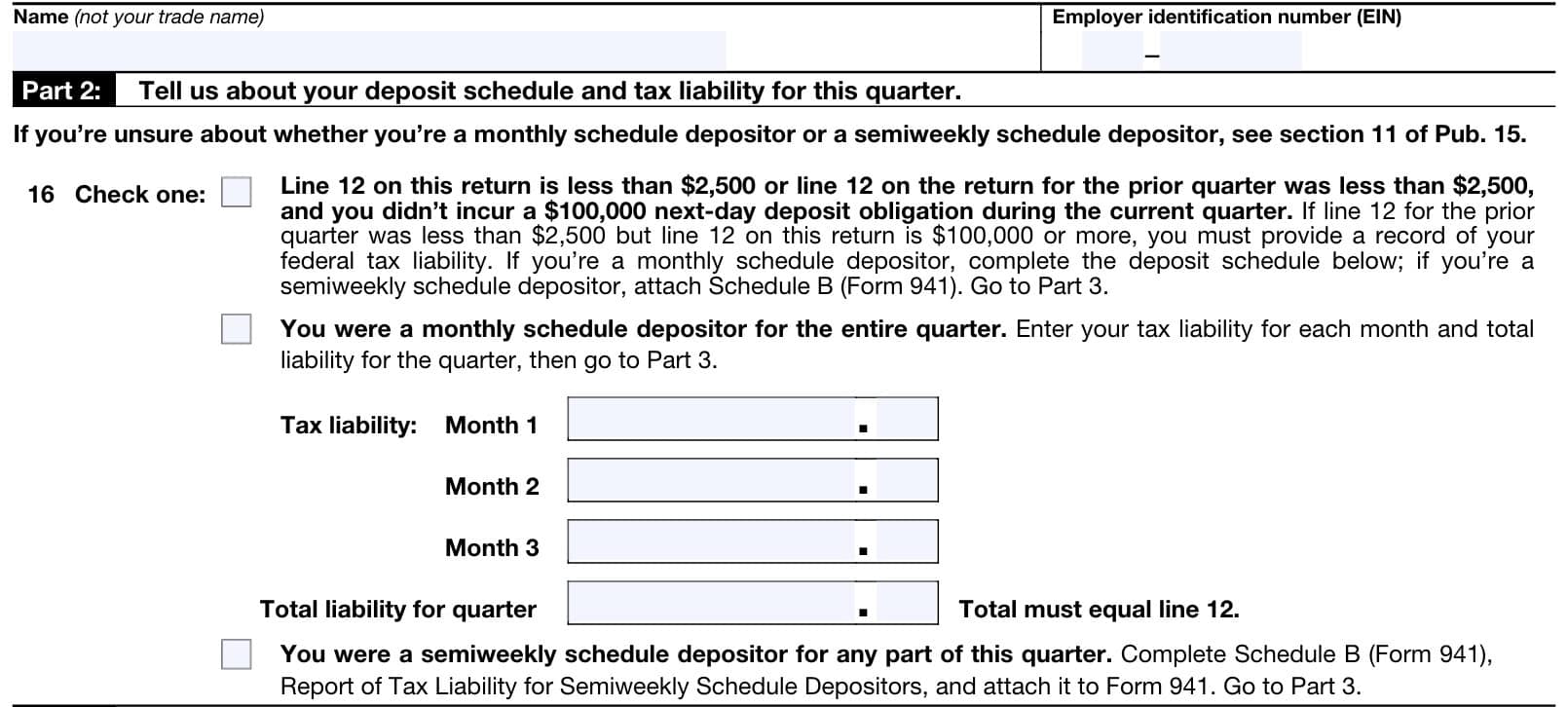
You were a semiweekly schedule depositor for any part of this quarter
Complete Schedule B (Form 941), Report of Tax Liability for Semiweekly Schedule Depositors, and attach it here.
Go to Part 3.
Part 3: Tell us about your business
Use Lines 17 and 18 to give the IRS more information about your business. If a particular question does not apply, leave it blank.
Line 17: If your business has closed or you stopped paying wages
If you go out of business or stop paying wages, you must file a final tax return.
To tell the IRS that a particular Form 941 is your final return, check the box here and enter the
final date you paid wages in the space provided.
Also attach a statement to your return showing the name of the person keeping the payroll records and the mailing address where those records will be kept.
Filing Schedule D
If you participated in a statutory merger or consolidation, or qualify for predecessor-successor status due to an acquisition, you should expect to file Schedule D (Form 941), Report of Discrepancies Caused by Acquisitions, Statutory Mergers, or Consolidations.
For more information, refer to the Schedule D instructions for IRS Form 941.

Line 18: If you’re a seasonal employer and you don’t have to file a return for every quarter of the year
If you hire employees seasonally check the box on Line 18. Checking the box tells the IRS not to expect four Forms 941 throughout the year because you haven’t paid employee wages on a regular basis.
Generally, the IRS won’t ask about unfiled returns if at least one taxable return is filed each year.
However, you must check the box on line 18 on every Form 941 you file. Otherwise, the IRS will expect a return to be filed for each tax quarter.
Part 4: May we speak with your third-party designee?
If you want to allow an employee, a paid tax preparer, or another person to discuss your Form 941 with the IRS, check the “Yes” box in Part 4. If you check “Yes,” then enter the following information for the specific person:
- Name
- Phone number
- Five-digit personal identification number (PIN)

Do not use the name of your tax preparation firm. Your designee may choose any five numbers as the PIN.
By checking “Yes,” you authorize the IRS to talk to the person you named (your designee) about any questions that come up while processing your tax return. You also authorize your designee to do all of the following:
- Provide the IRS any missing information from your return
- Call the IRS for information about processing your return
- Respond to certain IRS notices that you’ve shared with your designee about math errors and return preparation.
The IRS will not send notices to your designee. You are not authorizing your designee to bind your company to any additional obligations or to represent you before the IRS. If you wish to expand your designee’s authorization, you can find additional details in IRS Publication 947, Practice Before the IRS and Power of Attorney.
This authorization automatically expires 1 year from the due date for filing your Form 941.
Part 5: Sign here
Under penalties of perjury, sign and date the form in Part 5. On the right-hand side, print your name and title, and enter a daytime telephone number.
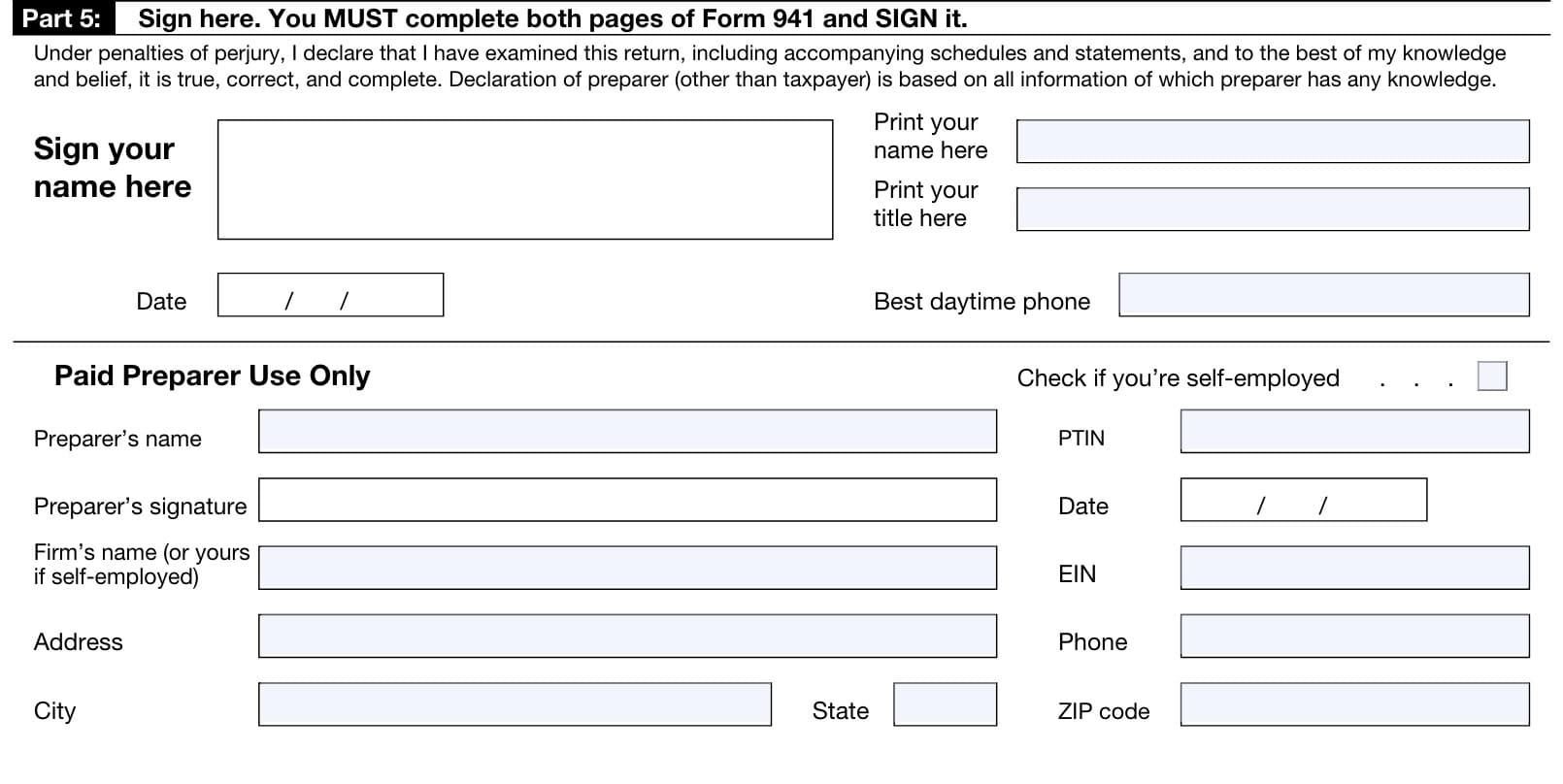
At the bottom, your tax preparer will complete the Paid Preparer Use Only section of Part 5.
Filing considerations
Below are some filing considerations for taxpayers when filing IRS Form 941.
Who must file IRS Form 941?
If you pay wages subject to federal income tax withholding or Social Security and Medicare taxes, you must file Form 941 quarterly to report the following amounts:
- Wages you’ve paid
- Tips your employees reported to you
- Federal income tax you withheld
- Both the employer and the employee share of Social Security and Medicare taxes
- Additional Medicare Tax withheld from employees
- Current quarter’s adjustments to social security and Medicare taxes for:
- Fractions of cents
- Sick pay & tips, and
- Group-term life insurance.
- Qualified small business payroll tax credit for increasing research activities.
Nonpayroll payments
Do not use IRS Form 941 to report backup withholding or income tax withholding on nonpayroll payments such as:
- Pensions
- Annuities
- Gambling winnings
Instead, report these withholdings on IRS Form 945, Annual Return of Withheld Federal Income Tax.
Unemployment taxes
Also, don’t use Form 941 to report unemployment taxes. Report unemployment taxes
on Form 940, Employer’s Annual Federal Unemployment (FUTA) Tax Return.
Additional Filing requirements
After you file your first Form 941, you must file a return for each quarter, even if you have no taxes to report, unless you filed a final return or one of the exceptions listed next applies.
Filing Exceptions
Special rules apply to some employers.
- If you received notification to file Form 944, Employer’s Annual Federal Tax Return, you must file Form 944 annually
- Don’t file IRS Form 941 quarterly
- Seasonal businesses don’t have to file a Form 941 for quarters in which they have no tax liability because they have paid no wages.
- Check the box on Line 18 every quarter you file Form 941.
- Employers of household employees don’t usually file Form 941.
- See IRS Schedule H, Household Employment Taxes (Form 1040) for more information.
- Employers of farm employees don’t file Form 941 for wages paid for agricultural labor.
- See IRS Form 943
When is IRS Form 941 due?
Your Form 941 is due by the last day of the month that follows the end of the quarter, as outlined in the below table:
| Quarter | Months included | Quarter end | Due date |
| First quarter | January, February, March | March 31 | April 30 |
| Second quarter | April, May, June | June 30 | July 31 |
| Third quarter | July, August, September | September 30 | October 31 |
| Fourth quarter | October, November, December | December 31 | January 31 |
How do I file IRS Form 941?
The IRS encourages taxpayers to file IRS Form 941 electronically through the IRS website.
Paper filing
If filing by hard copy, use the following schedule based on location and whether or not you are submitting payment:
| If you’re filing in… | Without a payment | With a payment |
| Connecticut, Delaware, District of Columbia, Georgia, Illinois, Indiana, Kentucky, Maine, Maryland, Massachusetts, Michigan, New Hampshire, New Jersey, New York, North Carolina, Ohio, Pennsylvania, Rhode Island, South Carolina, Tennessee, Vermont, Virginia, West Virginia, Wisconsin | Department of the Treasury Internal Revenue Service Kansas City, MO 64999-0005 | Internal Revenue Service P.O. Box 806532 Cincinnati, OH 45280-6532 |
| Alabama, Alaska, Arizona, Arkansas, California, Colorado, Florida, Hawaii, Idaho, Iowa, Kansas, Louisiana, Minnesota, Mississippi, Missouri, Montana, Nebraska, Nevada, New Mexico, North Dakota, Oklahoma, Oregon, South Dakota, Texas, Utah, Washington, Wyoming | Department of the Treasury Internal Revenue Service Ogden, UT 84201-0005 | Internal Revenue Service P.O. Box 932100 Louisville, KY 40293-2100 |
| No legal residence or principal place of business in any state, including employers in American Samoa, Guam, the CNMI, the USVI, and Puerto Rico | Department of the Treasury Internal Revenue Service P.O. Box 409101 Ogden, UT 84409 | Internal Revenue Service P.O. Box 932100 Louisville, KY 40293-2100 |
| Special filing address for exempt organizations: federal, state, and local governmental entities; and Indian tribal governmental entities, regardless of location | Department of the Treasury Internal Revenue Service Ogden, UT 84201-0005 | Internal Revenue Service P.O. Box 932100 Louisville, KY 40293-2100 |
What schedules do I need to file?
There are three schedules that taxpayers may need to file with Form 941:
- Schedule B, Report of Tax Liability for Semiweekly Schedule Depositors
- Schedule D, Report of Discrepancies Caused by Acquisitions, Statutory Mergers, or Consolidations
- Schedule R, Allocation Schedule for Aggregate Form 941 Filers
Although we do not cover these schedules here, we can take a closer look at when you might need to file each one.
Schedule B, Report of Tax Liability for Semiweekly Schedule Depositors
File Schedule B (Form 941) if you are a semiweekly schedule depositor. You are a semiweekly depositor if you:
- Reported more than $50,000 of employment taxes in the lookback period.
- Accumulated a tax liability of $100,000 or more on any given day in the current or prior calendar year.
Schedule D, Report of Discrepancies Caused by Acquisitions, Statutory Mergers, or Consolidations
In the case of acquisitions, mergers, or consolidations, employers use Schedule D (Form 941) to explain certain discrepancies between Forms W-2, Wage and Tax Statement, and Forms 941, Employer’s Quarterly Federal Tax Return, for the totals of:
- Social security wages
- Medicare wages and tips
- Social security tips, federal income tax withheld
- Advance earned income credit (EIC) payments
Schedule R, Allocation Schedule for Aggregate Form 941 Filers
Certain employers may need to allocate aggregate information as reported on Form 941 for multiple clients. For this, use Schedule R (Form 941) to allocate the aggregate information reported on Form 941 to each client.
If you have more than 15 clients, complete as many continuation sheets as necessary. Attach Schedule R, including any continuation sheets, to your aggregate Form 941.
How do I pay my taxes when filing IRS Form 941?
If there is an entry on Line 14, then you owe additional taxes.
If you were required to make federal tax deposits, then pay the amount shown on Line 14 by electronic funds transfer (EFT).
If you weren’t or you’re a monthly schedule depositor making a payment under the accuracy of
deposits rule, you may pay the amount shown on Line 14 by EFT, credit card, debit card, check, money order, or electronic funds withdrawal (EFW).
For more information on electronic payment options, go to IRS.gov/Payments.
If you pay by EFT, credit card, or debit card, file your return and don’t use Form 941-V, Payment Voucher.
Using IRS Form 941-V
If you pay by check or money order, then you should make it payable to “United States Treasury.”
Enter your EIN, “Form 941,” and the tax period (“1st Quarter 2024,” “2nd Quarter 2024,” “3rd Quarter 2024,” or “4th Quarter 2024”) on your check or money order.

Complete Form 941-V and enclose it with Form 941.
Video walkthrough
Watch this video to walk through each step of IRS Form 941.
Frequently asked questions
IRS Form 941, Employer’s QUARTERLY Federal Tax Return, is used to report wages you’ve paid and tips your employees have reported to you, as well federal income tax withheld, Social Security and Medicare taxes withheld, and your share of Social Security and Medicare taxes paid to the IRS.
You do not have to file IRS Form 941 for a quarter in which you did not pay employees, as long as you previously filed Form 941 and checked the box indicating that you are a seasonal employer. The IRS generally expects seasonal employers to file at least one Form 941 during the tax year.
Where can I find IRS Form 941?
You may find tax forms, such as IRS Form 941, on the IRS website. For your convenience, we’ve enclosed the latest version of this form here in our article.




